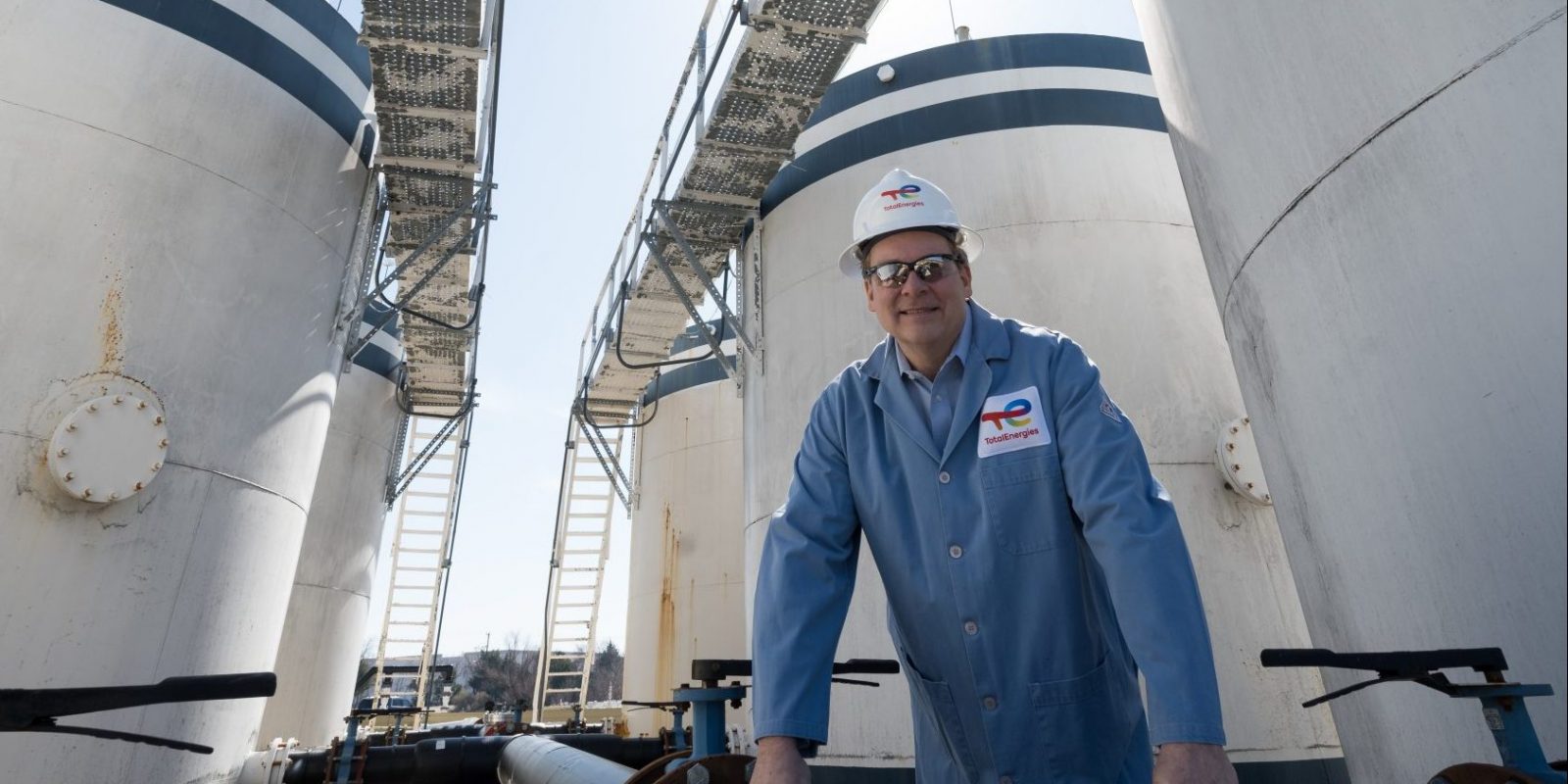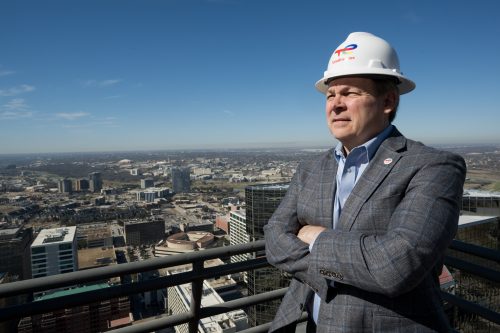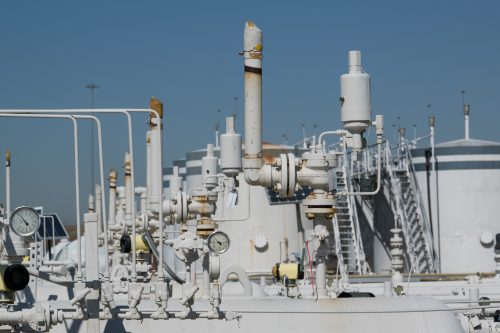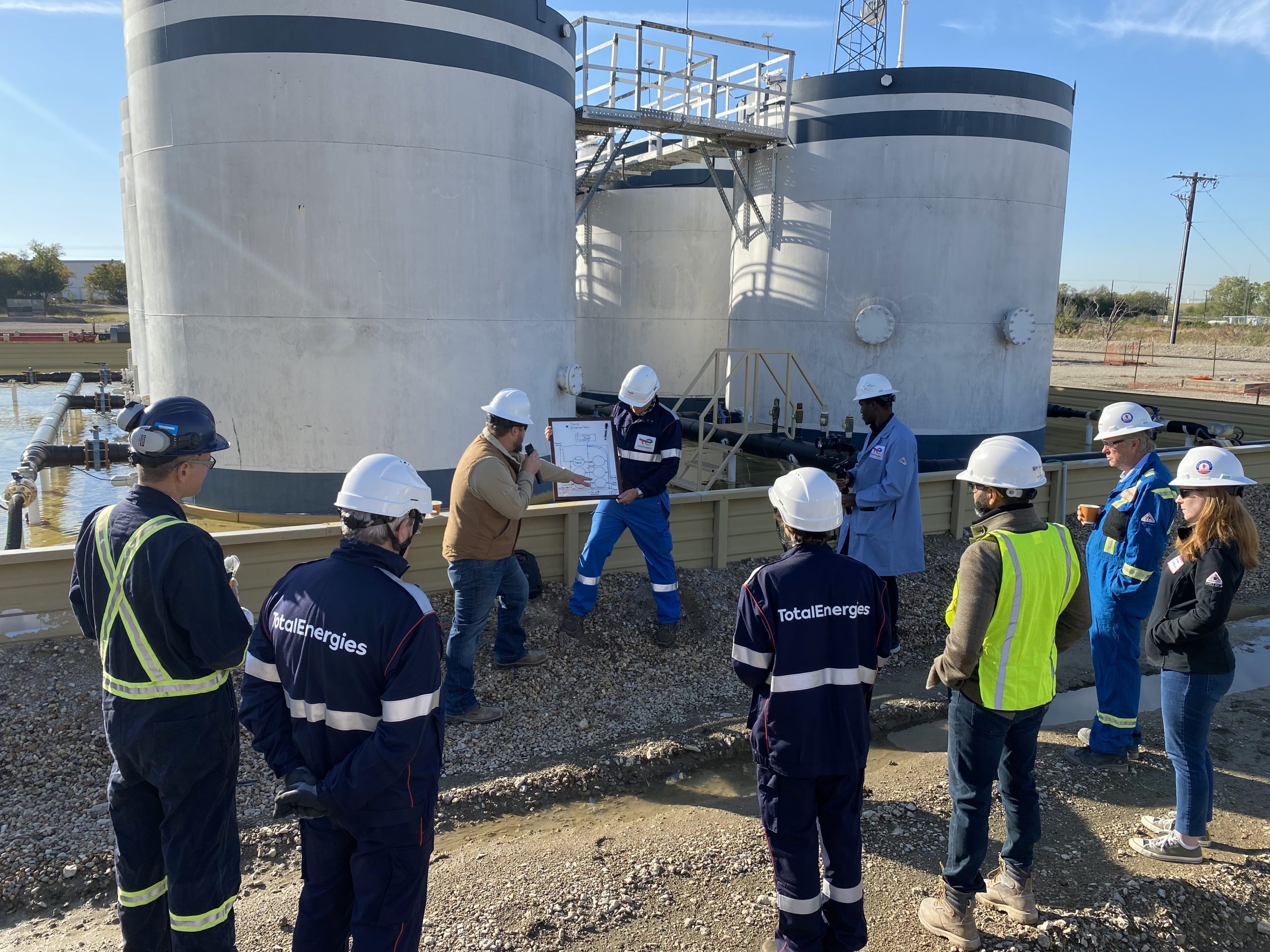
Pedal to the Light Metal
Drillers’ wastewater may yield pivotal energy-efficient metal.
On a flat stretch of land halfway between Dallas and Fort Worth sit several large storage tanks of water. But it’s not ordinary water — it’s salty wastewater piped from nearby shale gas wells as part of an ambitious plan to produce lithium, a key component of next-generation batteries.
French-owned TotalEnergies SE and Dave Leopold ’96 MBA, chief executive of Fort Worth-based TotalEnergies E&P-Barnett, are behind the effort. The company hopes to become the first in the United States to extract lithium from the wastewater produced in oil and gas drilling.
Just as the Spindletop gusher in Beaumont, Texas, launched the state’s oil boom more than a century ago, TotalEnergies could propel the state into the center of the nascent lithium industry. By reusing some of the waste generated from oil and gas drilling, the company could help pave the way for a clean energy transition.
Lithium, a super-light metal used in batteries for everything from power tools to cellphones, is in high demand. By far the biggest demand for lithium batteries comes from the electric vehicle industry.
“Lithium is as rare as gold.”
John Holbrook, professor of geological sciences at TCU.
Supply wasn’t a problem until demand began to skyrocket, he said.
The global lithium supply nearly doubled from 2018 to 2022, when 98 million tons were produced.
Demand is now rising much faster than supply; limited production and refining capacity could create a global shortage in just a few years.
“This is going to be a race between people’s demand for it and our ability to stay in front of it,” Holbrook said.
Amid this burgeoning and potentially lucrative landscape, TotalEnergies is one of several companies rushing to test ways to recover lithium from previously unused or underused sources.

Dave Leopold’s TotalEnergies E&P-Barnett could be a driver of turning Texas into a major center of the lithium industry. Global consumption of the metal has jumped 400 percent since 2014. Photo by Leo Wesson
The $200 billion, 105,000-employee TotalEnergies, which operates in more than 130 countries, launched its lithium recovery pilot last fall in North Texas. The project involves extracting lithium from water that is produced in natural gas production operations. The excess water is then injected into a disposal zone deep in the earth, Leopold said.
Frank Despinois, a research and development team leader for TotalEnergies who oversees the ongoing Texas pilot from France, called the preliminary results promising. The company is analyzing the data, but “if the results are good enough,” the next step would be to commercialize the process, he said.
TotalEnergies hopes to decide the program’s fate this year, said Leopold, a 30-year veteran of the oil industry. The 180 employees in his branch of the company have focused on natural gas exploration in the Barnett Shale.
The pilot is among the projects that will help TotalEnergies build a bridge between its fossil fuel business and the global focus on green energy. Two years ago, the company changed its name from Total to reflect its ongoing transformation from one of the world’s largest oil and gas operations into a multi-energy enterprise expanding into renewables like solar, wind and biofuels.
As part of its goal to be carbon-neutral by 2050, TotalEnergies has identified more than a dozen crucial metals to support its move toward more Earth-friendly resources.
“My goal is to unlock critical metals” and create a steady supply of them so that the company doesn’t face a shortage, said Despinois, a geoscientist.
Although lithium is a finite resource, the ability to capture it and recycle it is key. “Lithium will play a big role in battery production now and in the future,” Leopold said. “If everyone turns to electric cars and electric lawn mowers, we’re going to need more lithium.”
What Is Lithium?
“No one cared about it. Then we found out it’s the best way to make batteries for electric vehicles. The lithium industry has exploded beyond belief.”
Ken Hoffman, McKinney & Co.
Naturally occurring lithium is found all over — from ancient rocks to volcanic areas to groundwater — but in small amounts, Holbrook said.
Last year, 80 percent of the world’s recovered lithium went into batteries; it is also used in glass, ceramics, pacemakers and other products.
Metal is needed to store electricity, and lithium is the lightest metal that has strong heat and electrical conductivity. The lighter the batteries, the more efficient and less expensive the electric vehicles and other products will be.
Traditionally, lithium has been mined or extracted from rock in labor-intensive processes, but it’s also found in sediment, salty water such as brine and ancient seabeds. Production today is focused on recovering lithium from sources other than mining, which is an expensive, lengthy process.
Lithium production “was this sleepy little industry. … No one cared about it. Then we found out it’s the best way to make batteries for electric vehicles. The lithium industry has exploded beyond belief.”
With surging demand for clean energy, lithium consumption has jumped about 400 percent since 2014, he said. Prices also have skyrocketed. In 2022, the price of lithium carbonate, the type of lithium salt preferred for lithium-ion batteries, more than quadrupled, reaching a record of over $83,000 per ton.
Basic Supply and Demand
Global supply chain issues and carbon-neutral, net-zero goals are also driving the push to find new sources of lithium. The U.S. has set net-zero emission targets by 2050 amid growing concern about damage from rising global temperatures.
The opportunities are massive. The U.S. today produces less than 2 percent of the world’s lithium, while Australia, Chile and China take the lead.
Global energy demand has risen 30 percent in the past 10 years and is expected to continue growing, especially for electricity produced from green sources. The International Energy Agency forecasts demand for lithium could increase about 90 percent by 2040, with the world facing lithium shortages beyond the current decade.
“Our goal is to help supply the world with cleaner, safer energy and more affordable lithium products.”
Dave Leopold, TotalEnergies
That’s a concern for many, including leaders at TotalEnergies. The company’s initial aim is to find new sources of the metal to support its expansion into green energy.
“Right now, we are a small consumer of lithium, but that will change in the future,” Despinois said. TotalEnergies is part of a European joint venture with automakers Mercedes-Benz and Stellantis that plans to build gigafactories producing lithium batteries in the coming decades. The joint venture, Automotive Cells Co., will design and produce electric vehicles for the European market.
“Our goal is to not just do something for ourselves,” Leopold said. “Our goal is to help supply the world with cleaner, safer energy and more affordable lithium products.”
Treasure in the Brine
Lithium recovery from brine has attracted attention because of the abundant sources. “The groundwater beneath our feet is mostly briny,” Holbrook said. “There’s no shortage of brine.”
Oil and gas operations produce a lot of briny wastewater that is left over from the drilling process. That water may contain traces of chemicals used during drilling as well as metals like lithium that exist in the groundwater.

TotalEnergies diverts a fraction of the wastewater from oil and gas production into a series of storage tanks where it is treated to remove any impurities. Photo by Leo Wesson
Typically, about 4 barrels of brine are pumped up with every 1 barrel of oil or gas, Holbrook said. That wastewater is commonly stored in underground basins or saltwater disposal wells.
“Pretty much every single oil and gas well in North America has lithium content,” Hoffman said. “The question is how can we get at that lithium.”
TotalEnergies began planning its pilot in 2021 and launched it last fall. The company also built an artificial intelligence tool to help predict lithium concentration in oil and gas wells.
In North Texas, TotalEnergies evaluated about 1,200 sites before settling on a large saltwater disposal well near DFW International Airport that showed “a good concentration of lithium,” Despinois said. Wastewater generated during the gas drilling process was piped from dozens of nearby wells to the pilot site.
At the pilot site, which looks like a large gravel parking lot, TotalEnergies diverts a fraction of the wastewater into a series of storage tanks where it is treated to remove any impurities. Then a technique called adsorption extracts the lithium, which must go through further processing to become more concentrated. The result will be converted into a higher-grade lithium product.
The entire process takes a few hours.
The Future of Power
Pete Baldwin, a TCU Neeley Energy MBA student and vice president of business development at Harnyss, a hydrogen storage company in Fort Worth, volunteered for the TotalEnergies pilot project to learn more about lithium extraction. “I’m always amazed how waste can become a resource,” he said. “That’s truly the way to benefit all stakeholders — to turn waste into a new revenue stream.”
Baldwin is one of two Energy MBA interns working with the pilot. He and Cullen Cochran ’12 researched sites and their lithium potential as well as the tax and subsidy climate for lithium production.
“It really opened my eyes to what’s possible — I’m wondering how many other locations there are where this process could be set up,” said Cochran, a senior technical adviser for Enverus, an energy software provider in Dallas.
Leopold said hands-on training is important. In 2019, five TCU Energy students helped with TotalEnergies’ solar project in Fort Worth, which now powers three-quarters of the field office’s power needs. Solar is expected to supply 100 percent of the office’s needs next year, he said.
“I want to make sure our students have access to new technology and experiences,” said Leopold, chair of the advisory board for TCU’s Ralph Lowe Energy Institute.
During the pilot, TotalEnergies has produced about 5 tons of lithium chloride, Despinois said.
“We’re testing a new geologic concept and trying to make it economical,” he said. “It’s a completely new business that we can unlock for the company.”
TotalEnergies’ evaluation process not only aims to ensure that lithium extraction is technically and financially feasible, but also that it’s environmentally sound, Despinois said.
“I’m hopeful that we will be able to increase the supply of lithium for the manufacturing of batteries, which will go toward our goal of providing a more sustainable energy future,” Leopold said. “While our company continues the transition to more sustainable energies, it is a progression and won’t happen overnight.”

TotalEnergies employees are constantly discovering new things about lithium production. Photo by Cullen Cochran

Your comments are welcome
Comments
Related Reading:
Features
A Prescription for Success
TCU’s health policy program from the Neeley School of Business trains medical industry professionals in the business of health care.
Features
Campus of the Future
TCU’s Campus Master Plan builds on the university’s vision and values.